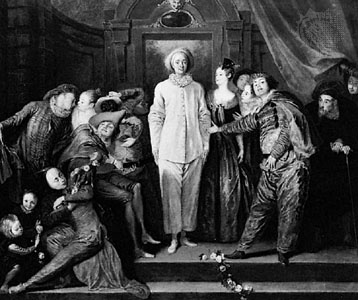Comédie-Italienne
French theatre
 the Italian commedia dell'arte as it was called in France. The name was used in France after 1680 to distinguish the commedia dell'arte from native French drama produced at the Comédie-Française. Italian commedia dell'arte companies appeared in France from the 16th century and pleased both the courtiers, who understood Italian, and the populace, which enjoyed the improvised antics, dialogue, and pantomime. In 1697, however, their satire was found offensive, and the companies were banished from France.
the Italian commedia dell'arte as it was called in France. The name was used in France after 1680 to distinguish the commedia dell'arte from native French drama produced at the Comédie-Française. Italian commedia dell'arte companies appeared in France from the 16th century and pleased both the courtiers, who understood Italian, and the populace, which enjoyed the improvised antics, dialogue, and pantomime. In 1697, however, their satire was found offensive, and the companies were banished from France.Prior to 1697 the Comédie-Italienne, at the urging of the French audiences, had increasingly interspersed French words, phrases, and sometimes whole scenes into productions. A leader of one company, Giuseppe Domenico Biancolelli, known as Dominique, eventually received official sanction from Louis XIV to use French, and thereafter the Comédie-Italienne became a new market for French dramatists.
In 1716, when Italian players were allowed to return to France, they began performing French works by French dramatists, particularly Pierre Marivaux, and from that time only some of the spirit of the commedia dell'arte—foreign flavour and the ribaldry, drolleries, pantomime, as well as some of the characters—remained. French actors gradually replaced the Italians; the last great Italian Arlequin (Harlequin) was Carlo Bertinazzi (1710–83), known as Carlin. Increasingly, their productions turned toward opéra-bouffe (comic opera). In 1801 the Comédie-Italienne merged with a former rival, the Théâtre Feydeau, to form the Opéra-Comique, and the Italian companies were dissolved.
- Tower of Hercules
- Tower of London
- Tower of the Winds
- towhee
- Towle, Katherine Amelia
- Towne, Laura Matilda
- Townes, Charles Hard
- town meeting
- Townsend family
- Townsend Harris
- Townsend, Sir John Sealy Edward
- Townshend Acts
- Townshend, Charles
- Townshend, Charles Townshend, 2nd Viscount
- township
- Townsville
- Towson
- Towton, Battle of
- toxaphene
- toxemia of pregnancy
- toxicology
- toxic shock syndrome
- toxin
- Toxodon
- toxoid